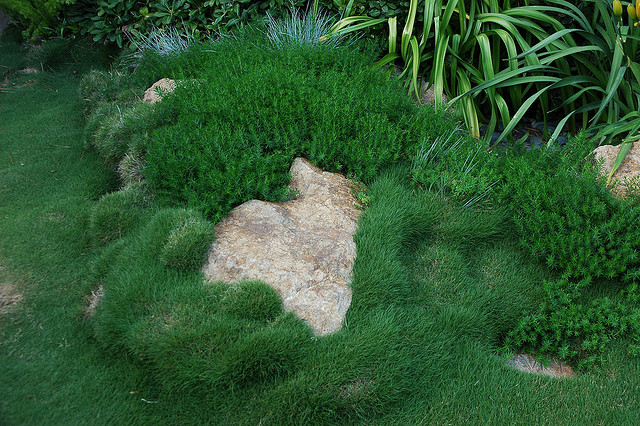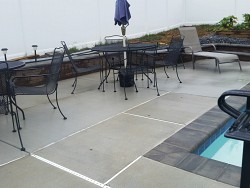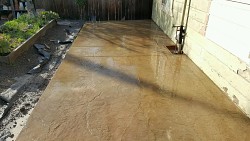Low-Maintenance, Eco-Friendly Lawns
 A lush green lawn is lovely in theory, but in actual practice, it tends to be a major hassle. Mowing and weeding are just plain hard work, and the amount of water necessary to maintain a traditional lawn is unconscionable, especially in regions that are plagued with drought. For all these reasons, more and more alternatives to high-maintenance lawns are being developed these days. Read about some of the most popular.
A lush green lawn is lovely in theory, but in actual practice, it tends to be a major hassle. Mowing and weeding are just plain hard work, and the amount of water necessary to maintain a traditional lawn is unconscionable, especially in regions that are plagued with drought. For all these reasons, more and more alternatives to high-maintenance lawns are being developed these days. Read about some of the most popular.
Synthetic Grass
Synthetic grass needs absolutely no watering and can be "grown" on any kind of terrain. However, it looks and feels fake unless you go for the top quality, which just happens to be the most expensive. Beyond that, on sunny summer days, synthetic grass gets hot underfoot and can off-gas potentially toxic -- and unpleasant-smelling -- chemicals. In terms of lawn maintenance, you will need to wash it down once in a while and deal with removing fallen leaves in the autumn. As well, fake grass has a tendency to mat in spots. It will last, on average, 15-20 years and after that must be disposed of. Recycling facilities are limited at the current time.
Ground Cover
Ground cover is the term that describes any low-growing herbaceous perennial plant which can be used to cover the ground in place of grass. Many of these are quite robust and attractive, with low lawn care and maintenance, minimal watering, and no mowing. Two examples of ground covers which are becoming very trendy in landscaping today are wooly thyme and moss.
Wooly thyme is a silvery-green hardy herb that requires a minimal amount of care and is very resistant to crushing. It is suited to USDA Zones 4-7, and potentially as far as zone 9 if it is grown in a sheltered spot. Good-looking and sweet-smelling, wooly thyme's leaves can be used in cooking.
Moss is soft and green, perfect for lying on with a book on a lazy summer afternoon. Moss lawns will thrive in shade or on poor soil, and consume far less water than grass does. Another fringe benefit? It needs no mowing ever! Cautions: Moss does not do well in hot, sunny climes and cannot handle heavy trampling.
Low-Maintenance Grass
If you love the look of grass, but want to simplify your lawn care and maintenance routine, choose a variety that needs infrequent cutting and watering, such as fescue or mondo grass.
Fescue grass stands up well to both foot traffic and drought in USDA zones 1-7. It does need plenty of moisture when it is first planted, however, and as a cool season grass, it may turn brown in very hot weather, rebounding in the cooler fall months.
Mondo grass, AKA "monkey grass," is an Asian plant with a strong resemblance to grass, but without the hard work. It comes in two versions: regular, which grows up to 16" high and needs minimal mowing, and dwarf, whose maximum height is only 2". Mondo has smooth, fine to medium, dark green leaves, which retain their color year-round.
Meadow
A meadow, also called a "sward" or "wild lawn," is a colorful and resilient mixture of broad-leafed, laterally spreading flowering plants, that may or may not include grass. Dr. Lionel Smith conducted his PhD research project at the University of Reading, England, by cultivating grass-free lawns from as many as 65 different species. Not only were his green patches less susceptible to disease than traditional grass lawns, they were also "pollinator-friendly," attracting 25 percent more insect life. In the US, lawn seeding mixtures such as Fleur de Lawn offer a blend of grasses and flowers like sweet alyssum and nitrogen-fixing clover.
Laura Firszt writes for networx.com.
Looking for a Pro? Call us (866) 441-6648

Landscaping Average Costs
Landscapers Experiences

Seamless Extension Of Concrete Patio And Poolside Retaining Wall

Yard Cleanup By A Local Landscaper Who Cares About Customers



